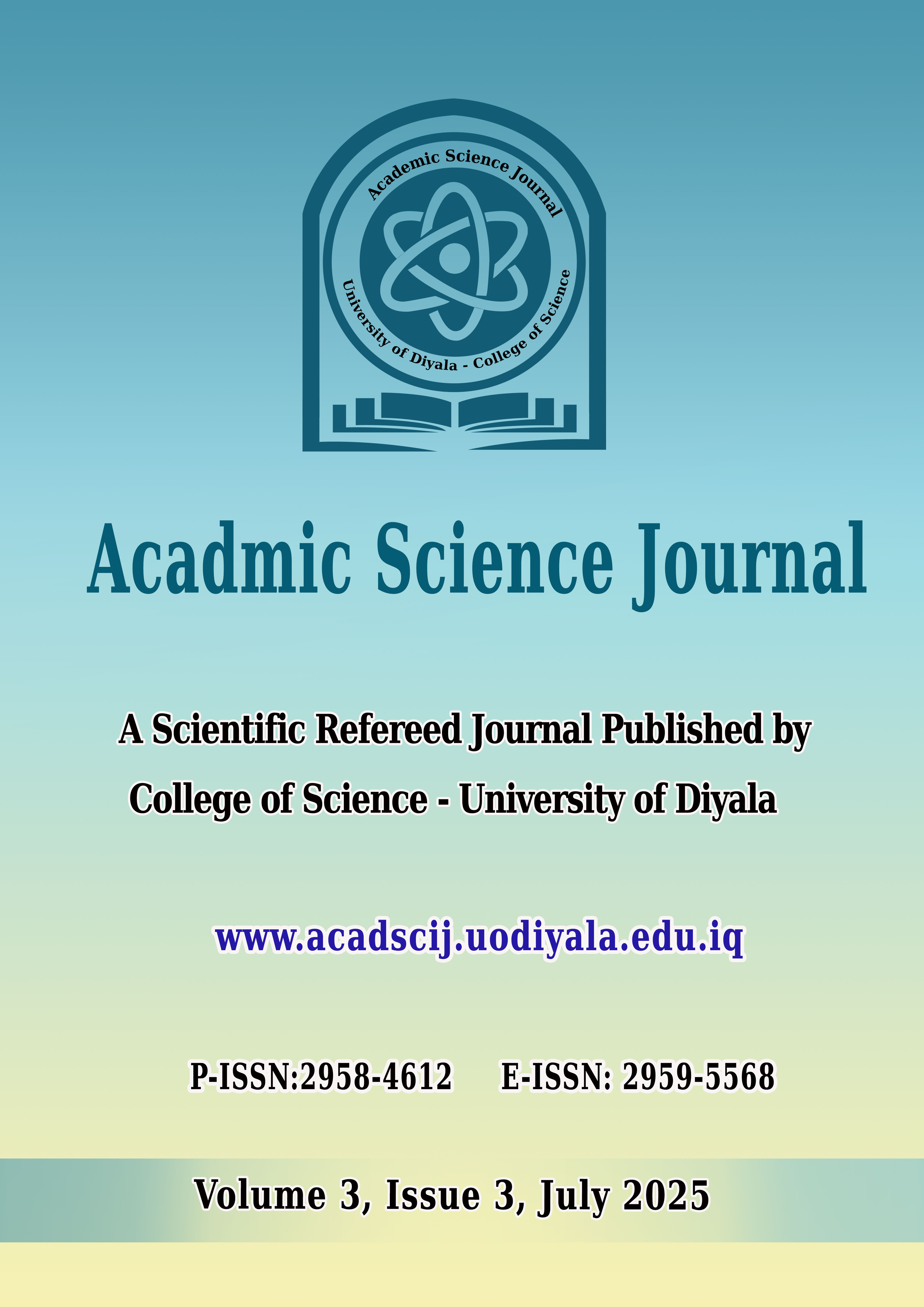Detection of Some Virulence Factors and aac(6)Ib Resistance Gene in Clinical Proteus mirabilis isolates
DOI:
https://doi.org/10.24237/ASJ.03.03.878BKeywords:
P. mirabilis, biofilm, amikacin, virulent factors, PCR, aacIbAbstract
The Proteus mirabilis. are opportunistic members of Enterobacteriaceae ,accounting for 10% of urinary tract infections and other primary clinical infections. They produce beta-lactamases that can confer resistance to beta-lactam antibiotics. This study aimed to investigate the prevalence of some virulence factors with antimicrobial resistance and molecular characteristics of aac-Ib gene The current study have been included 250 specimens were collected from urine sample, wound, burn, diabetic foot, and vaginal swabs conducted in Baquba Teaching Hospital, Al-Batool Teaching Hospital, and AlKhalis hospital in Diyala province during the period extended from August 2023 to January 2024. A total of 250 specimens Isolates were identified by morphological form on blood agar and macConkey agar, traditional biochemical tests. The results showed that 75 isolates were identified as P. mirabilis (30%) consisted of 35 isolates (46.7%) obtained from urine, 8 isolates (10.7%) obtained from wound, 10 isolates (13.3%) obtained from burns and diabetic foot and 12 isolates (16%) obtained from vaginal swabs. The higher rate of positive isolates were recorded in urine samples. Females isolation rate was much more than in males 60% and 40% respectively and patients age group 21- 30 year was more prevalence than other groups. It was found that the more effective antibiotic against isolates was the norfloxacin followed by levofloxacin, where all isolates were sensitive to it. On the other hand, the less effective antibiotics were amikacin and oxacillin when they were resisted by all isolates.
Downloads
References
[1] Tasnim, A., Alam, M. S., Yusuf, M. A., Khan, F. A., Ferdose, J., & Sultana, M. (2021). Prevalence of multidrug resistant (MDR) Proteus spp. in burn wound infection of a tertiary care hospital, Rajshahi. Int. J. Infect. Dis. Ther, 6(2), 65.
[2] Schaffer, J. N. and Pearson, M. M. (2017). Proteus mirabilis and urinary tract infections. Urinary Tract Infections: Molecular Pathogenesis and Clinical Management, 383-433
[3] Zheng, X.; Ma, J.; Lu, Y.; Sun, D.; Yang, H.; Xia, F. and Tang, B. (2022) Detection of tet (X6) variant–producing Proteus terrae subsp. Cibarius from animal cecum in Zhejiang, China. Journal of Global Antimicrobial Resistance, 29, 124-130.
[4] Hamilton, A. L.; Kamm, M. A., Ng, S. C. and Morrison, M. (2018). Proteus spp. as putative gastrointestinal pathogens. Clinical Microbiology Reviews, 31(3), 85-98.
[5] Sun, Y., Wen, S., Zhao, L., Xia, Q., Pan, Y., Liu, H., ... & Wang, H. (2020). Association among biofilm formation, virulence gene expression, and antibiotic resistance in Proteus mirabilis isolates from diarrhetic animals in Northeast China. BMC veterinary research, 16, 1-10.
[6] Delphine, G., A. B. Remy, D. Laurent, and N. Thierry. 2020. Genetics of acquired antibiotic resistance genes in Proteus spp. Front. Microbiol. 11. https://doi.org/10.3389/fmicb.2020.00256
[7] Friedrich AW, Koch R, Bielasz ewska M, Zhang W, Karch H, Mathys W. Distribution of the Urease gene cluster among urea activity of enterohemorrhagic Escherichia coli OH157 isolated from humans. J. of Clin. Micr. (2005); 43(2)546-550.
[8] Forbes, B. A., Sahm, D. F., & Weissfeld, A. S. (2016). Study Guide for Bailey and Scott's Diagnostic Microbiology-E-Book. Elsevier Health Sciences.
[9] MacFaddin.2000.Biochemical tests for identification of medical bacteria. Lippincott Williams and Wilkins, USA.=19-Manos, J. and Belas, R. 2006. The genera Proteus, Providencia, and Morganella. Prokaryotes. 6:245–269.
[10] CLSI. (2023). Performance Standards for Antimicrobial Susceptibility Testing. 27th ed. Wayne, PA: Clinical and Laboratory Standards Institute.
[11] Kang, M.-S., Yeu, J.-E., and Hong, S.-P. (2019). Safety evaluation of oral care probiotics Weissella cibaria CMU and CMS1 by phenotypic and genotypic analysis. Intern. J. Mol. Sci. 20:2693. doi: 10.3390/ijms20112693
[12] Benson H G (2002) Microbiological Applications ( Laboratory Manual in General Microbiology). Eighth edition published by McGraw – Hill, New York
[13] Pfaller, M. A., Mujeeb, I., Hollis, R. J., Jones, R., and Doern, G. V. (2000). Evaluation of the discriminatory powers of the dienes test and ribotyping as typing methods for Proteus mirabilis. J. Clin. Microbiol. 38, 1077–1080. doi: 10.1128/jcm.38.3.1077-1080.2000
[14] Sharma, S. and Mall, A. (2011). The prevalence, antibiogram and characterization of methicillin resistant Staphylococcus aureus among the patients from the Doon Valley hospitals. Afr. J. Microbiol. Res. 5(21): 3446-3451/
[15] Mathur, T., Singhal, S., Khan, S., Upadhyay, D., Fatma, T. & Rattan, A. (2006). Detection of biofilm formation among the clinical isolates of staphylococci: an evaluation of three different screening methods. Ind. J. of med. microbio., 24: 25.
[16] Abdullah, P. B., Khalid, H. M., & Mero, W. M. (2022). Molecular characterization and antibiotic susceptibility of Proteus mirabilis isolated from different clinical specimens in Zakho city, Kurdistan Region, Iraq. Zanco Journal of Pure and Applied Sciences, 34(5), 198-207.
[17] Gomaa, S., Serry, F., Abdellatif, H., & Abbas, H. (2019). Elimination of multidrug-resistant Proteus mirabilis biofilms using bacteriophages. Archives of virology, 164, 2265-2275..
[18] Kamil, T. D., & Jarjes, S. F. (2019). Isolation, identification, and antibiotics susceptibility determination of Proteus species obtained from various clinical specimens in Erbil City. Polytechnic Journal, 9(2), 15
[19] Mirzaei, A., Nasr Esfahani, B., Raz, A., Ghanadian, M., & Moghim, S. (2021). From the urinary catheter to the prevalence of three classes of integrons, β-lactamase genes, and differences in antimicrobial susceptibility of Proteus mirabilis and clonal relatedness with Rep-PCR. BioMed research international, 2021.
[20] Saleh Al-Dulaimi, M. T., & Rasheed Al-Taai, H. R. (2020). detection of some virulence factors and antibiotics susceptibility of proteus mirabilis isolated from different clinical sources in baquba. Biochemical & Cellular Archives, 20(1).
[21] Al-Nabhani, N. A., & Shami, A. M. (2023). Molecular Study of Carbapenem Resistance Genes in Proteus mirabilis Isolated from Clinical Samples in Baghdad Hospitals. Iraqi journal of biotechnology, 22(1)
[22] Zafar, U.; Taj, M. K.; Nawaz, I.; Zafar, A.; and Taj, I. (2019). Characterization of Proteus mirabilis Isolated from Patient Wounds at Bolan Medical Complex Hospital, Quetta. Jundishapur Journal of Microbiology, 12(7), 1-6 .
[23] Mirzaei A., Habibi M., Bouzari S., Asadi Karam MR. (2019). Characterization of Antibiotic-Susceptibility Patterns, Virulence Factor Profiles and Clonal Relatedness in Proteus mirabilis Isolates from Patients with Urinary Tract Infection in Iran. Infection and Drug Resistance, 12: 3967–3979.
[24] Al-Mayahi, F. S. (2017). Phenotypic and Molecular detection of Virulence factors in Proteus mirabilis isolated from different clinical sources. Bas J Vet Res, 16(1), 369-88.
[25] Abdullah, M. M. (2019). The effect of nanoparticles on rsbA gene expression level in Proteus spp. isolated from Iraq urinary tract infected patients Master Thesis . College of Science . Baghdad University.
[26] Hussein, E. I., Al-Batayneh, K., Masadeh, M. M., Dahadhah, F. W., Al Zoubi, M. S., Aljabali, A. A., & Alzoubi, K. H. (2020). Assessment of pathogenic potential, virulent genes profile, and antibiotic susceptibility of Proteus mirabilis from urinary tract infection. International journal of microbiology, 2020.
[27] Al-Kaim, H. W., & Al-Dahmoshi, H. O. (2023). Prevalence of AcrAB-TolC efflux pump among Proteus mirabilis isolated from cystitis patients in Hilla City, Iraq. Medical Journal of Babylon, 20(3), 503-510.
[28] Jamel, A. N., Allami, R. H., & Hamza, S. J. (2020). Molecular study of rpoB gene In Proteus mirabilis isolated from urinary tract infection from different hospitals in Baghdad. Plant Archives, 20(1), 2379-2383.
[29] Laxminarayan, R., Matsoso, P., Pant, S., Brower, C., Røttingen, J. A., Klugman, K., & Davies, S. (2016). Access to effective antimicrobials: a worldwide challenge. The Lancet, 387(10014), 168-175.
[30] Firmo, E. F., Beltrão, E. M. B., da Silva, F. R. F., Alves, L. C., Brayner, F. A., Veras, D. L., & Lopes, A. C. S. (2020). Association of blaNDM-1 with blaKPC-2 and aminoglycoside-modifying enzyme genes among Klebsiella pneumoniae, Proteus mirabilis and Serratia marcescens clinical isolates in Brazil. Journal of Global Antimicrobial Resistance, 21, 255-261.
[31] Gangoue-Pieboji J, Koulla-Shiro S, Ngassam P et al. Antimicrobial activity against gram-negative bacilli from Yaounde Central Hospital, Cameroon. Afr. Health Sci., Vol. 6(4), (2006); pp: 232-235.
[32] Filimon R, Iacob E. Incidence of nosocomial infection at the recovery clinic of Iasi hospital in 2004-2005. Rev. Med. Chir. Soc. Med. Iasi. (2007); 111(1): 255-257.
[33] Elhoshi, M., El-Sherbiny, E., Elsheredy, A., & Aboulela, A. G. (2023). A correlation study between virulence factors and multidrug resistance among clinical isolates of Proteus mirabilis. Brazilian Journal of Microbiology, 54(3), 1387-1397.
[34] Drzewiecka, D. (2016). Significance and roles of Proteus spp. bacteria in natural environments. Microbial ecology, 72, 741-758.
[35] Li, Z., Peng, C., Zhang, G., Shen, Y., Zhang, Y., Liu, C., ... & Wang, F. (2022). Prevalence and characteristics of multidrug-resistant Proteus mirabilis from broiler farms in Shandong Province, China. Poultry science, 101(4), 101710.
[36] Hussein, M. A., & AL-Shwaikh, R. M. A. (2020). PHENOTYPIC DETECTION OF β-LACTAMASE AND EXTENDED-SPECTRUM β-LACTAMASE PRODUCTION IN MULTIDRUG-RESISTANT PROTEUS MIRABILIS. Biochemical & Cellular Archives, 20(2).
[37] Girlich, D., Bonnin, R. A., Dortet, L., & Naas, T. (2020). Genetics of acquired antibiotic resistance genes in Proteus spp. Frontiers in microbiology, 11, 500668.
[38] Ram, P., Rao, V., Rao, S., Subramanyam, K. V., & Srinivas, K. (2019). Prevalence and virulence gene profiles of Proteus mirabilis isolated from animal, human and water samples in Krishna District, Andhra Pradesh, India. Pharma Innov. J, 8(6), 19-23
[39] Auer, G. K., Oliver, P. M., Rajendram, M., Lin, T. Y., Yao, Q., Jensen, G. J., & Weibel, D. B. (2019). Bacterial swarming reduces Proteus mirabilis and Vibrio parahaemolyticus cell stiffness and increases β-lactam susceptibility. Mbio, 10(5), 10-1128.
[40] Filipiak, A., Głuszek, S., & Adamus-Białek, W. (2020). Pathogenic factors correlate with antimicrobial resistance among clinical Proteus mirabilis strains. Frontiers in microbiology, 11, 579389
[41] Dincer, S.; Uslu, F.M. and Delik, A. (2020). Antibiotic Resistance in Biofilm. In Bacterial biofilms. IntechOpen
[42] Garde, C. ; Martin, W.; Jesper, F.B. and Thomas, S. (2015). Microbial biofilm as a smart material. Sensors: 15: 4229-4241.
[43] Garibyan, L. and Avashia, N., (2013). Research techniques made simple: polymerase chain reaction (PCR). The Journal of investigative dermatology, 133(3), pp.e6.
[44] Al-Saadi, L. A. S., Ali, I. A., & Abbas, S. A. (2022, November). Molecular analysis of Proteus mirabilis virulence genes isolated from urinary tract infections from Baquba teaching hospital. In AIP Conference Proceedings (Vol. 2394, No. 1). AIP Publishing.
[45] Abed, G. E., Salim, H. A., & Fadhil, H. W. (2022). Study of Some Resistance Genes in Clinical Proteus mirabilis.
[46] Alsherees, H. A. A., Abdzaid, A. J., & Talib, R. (2016). Molecular study of Proteus mirabilis bacteria isolated from urine and wounds in hospitals Al-Najaf province. Int J Adv Res Biol Sci, 3(6), 99-105.
[47] Alabi, O. S., Mendonça, N., Adeleke, O. E., & da Silva, G. J. (2017). Molecular screening of antibiotic-resistant determinants among multidrug-resistant clinical isolates of Proteus mirabilis from SouthWest Nigeria. African health sciences, 17(2), 356-365.
Downloads
Published
Issue
Section
License
Copyright (c) 2025 CC BY 4.0

This work is licensed under a Creative Commons Attribution 4.0 International License.





